by Winding Pathways | Jan 16, 2025 | (Sub)Urban Homesteading, Garden/Yard, Garden/Yard
Seed Catalog Reading
We trudged through the snow to retrieve our first garden catalog. Excited! So, we wondered what our gardening friends thought of about the best garden vegetables to grow in tiny spaces. They replied about small spaces and in general.
Garden seed catalogs hold spring’s promise in your hands. These seem to sprout in mailboxes during winter’s depth. In addition to being fun reading on dark winter nights, they help plan springtime seed planting.
Changing How We Garden
We have plenty of space at Winding Pathways to create a big garden, but we decided to grow vegetables on two small garden plots years ago. Their modest size makes them easy to manage, but mostly we wanted to learn how to grow a maximum amount of the best garden vegetables from a small area. Not everyone has large spaces and as people age adapting to how they continue to enjoy a practice, like gardening, is important.
During the 2024 growing season, our gardens produced an amazing amount of food. We saved money by providing ultra-fresh pesticide-free vegetables and enjoyed nearly year-round tasty vegetables.
Readers Share Their Best Garden Vegetables
We asked a few seasoned gardeners what their favorite small space crop is.
Master gardener, Iris Muchmore, has a small backyard garden. Her absolute favorite planting is a Sun Gold Tomato. She points out that tomatoes aren’t really vegetables. They’re a fruit, but most folks consider them a vegetable. “The Sun Gold tomato is indeterminate, tasty, as sweet as candy, and productive. Children love them. One plant will grow up to seven feet tall and produce all the tomatoes a family can eat with some extras for neighbors. In 2024 we enjoyed tomatoes from June until frost from one plant,” she said.
Jackie Hull is a seasoned Virginia gardener. Her favorite vegetables are string beans, both green and yellow. She’s 83 years old and grows beans in large pots on her porch. “It makes gardening easy. There’s no weeding, only watering and picking,” she remarked.
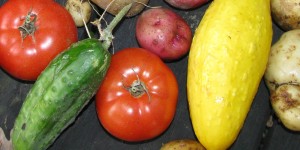
Tasty high summer garden fruits and vegetables.
Bruce Bachman & Nancy Sauerman buy from Pinetree Garden Seeds in Maine. They comment that their favorite garden vegetable is a “…tie between tomatoes and green beans. Although potatoes, chard, and broccoli are close seconds.” Then they added with a laugh, “Oh! forgot summer and winter squash! Oops, and okra and spring lettuce.” All favorites of theirs.
Iowa Gardener, Dave Kramer, responded by stating, “I like the challenge of growing different tomato varieties and growing string beans”
Kurt Rogahn also weighed in, choosing tomatoes as his favorite. “Tomato is my favorite. The ones in the store are so tasteless! I like different varieties— red, yellow, orange, big and small.”
Jill Jones, could hardly decide as she likes just about all vegetables. And, she prepares delicious dishes from her garden produce.
Joann Hoffmann weighed in with these thoughts: She starts greens in a colander!
“I would say my favorite is a nice salad mix with arugula, red lettuce and green lettuce. You can grow it in a colander. It’s an early vegetable, likes cool weather. It makes a great base for salads all summer long. You can start it in April when it’s too early for other vegetables. As the season progresses you can add kale, swiss chard, turnup greens, mustard greens, mint, peppermint, tomatoes, cucumbers, spinach, and cilantro. Try it and enjoy great tasting salads all summer long!!”

Our Favorite Vegetable For Small Spaces
We’ve gardened for about 50 years, growing all sorts of vegetables, and are constantly experimenting with new varieties. Along the theme of Small spaces” here is our number one favorite:
Swiss Chard: Chard is a green delicious when steamed or raw in salads. We plant it in April and often eat young leaves within a month. Unlike spinach and lettuce, chard doesn’t bolt, or go to seed, and get bitter. So, we eat chard from the same clump for about five months without replanting. About two square feet of space produce all the chard we can eat. It’s an outstanding plant for folks who live in apartments and only can grow a few things in pots on the deck.
Susan Fellows is one of those people. “It’s not strong like the greens grown in the South and less strong than spinach.” She enjoys snipping off a few leaves, steaming them, and adding butter. Delicious and nutritious!
Swiss chard is the same species as beet but it’s been developed as a green vegetable. There are several varieties. All are good. Beet tops are also delicious when steamed, but they are a bit stringier and tougher than chard.
Number Two of Best Garden Vegetables
Green and yellow beans are our second favorite for our small space garden. We use two methods to create a constant harvest from June through October. We plant a small patch of bush beans in May. They produce beans quickly and the plot yields heavily for a month before the plants peter out. Anticipating this, we start another small bean plot several feet away about a month after the first planting. By the time the first plot is done, the second one starts producing like crazy. We also plant a row of pole beans next to a garden fence. They mature slower than bush beans but produce from August until frost. String beans provide great food for nearly every dinner for months.

Promise of spring
Enjoy leafing through winter garden catalogs and place seed orders early in anticipation of delicious 2025 eating. Be sure to put Sun Gold, string beans, and Swiss chard on the order list.
Some quality seed companies we buy from:
Pinetree Seeds, New Gloucester ME
Seed Savers, Decorah, IA
Gurney’s Seed and Nursery, Greendale, IN
Burpee, Warminster Township, PA
Jung Seeds & Plants, Randolph, WI
by Winding Pathways | Jan 9, 2025 | Labyrinths, Reflections/Profiles, Ruminations
Winter and Spring
Each January I post about visiting labyrinths during the years. Below are Labyrints 2024 that we visited.
January kicked off the year with a fun and moderately mild weather visit to a childhood friend and her family who now live in Wisconsin. We walked in Wauwatosa’s Hartung Park, where the community has installed an engaging labyrinth for all ages to enjoy. Watch as this youngster romped along the path looking for the icicle fairies who feed the Voogans. These are imaginary creatures, tall as a house, who live in the park.
Prairiewoods Spirituality Center in Hiawatha, IA, hosted a series of cross-quarter date labyrinth walks. The first, known in various cultures as Imbolc, St. Bridgit’s Day, or Candlemas, marks the halfway point between the winter solstice and the vernal equinox.
Early April we trekked to Arkansas for the total eclipse and to catch up with Veriditas and Outdoor Writer friends. The paved labyrinth at Hendrix College is special to Twylla Alexander who hosts special walks with her family in the holiday season.
-
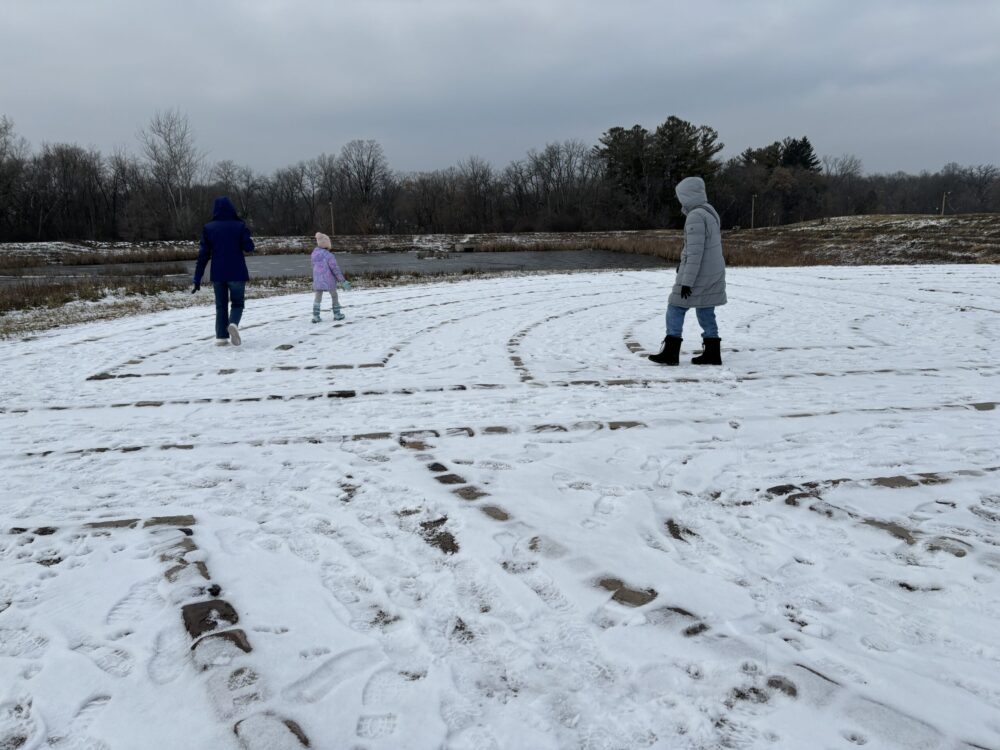
-
Hartung Park, Wauwatosa, WI
-
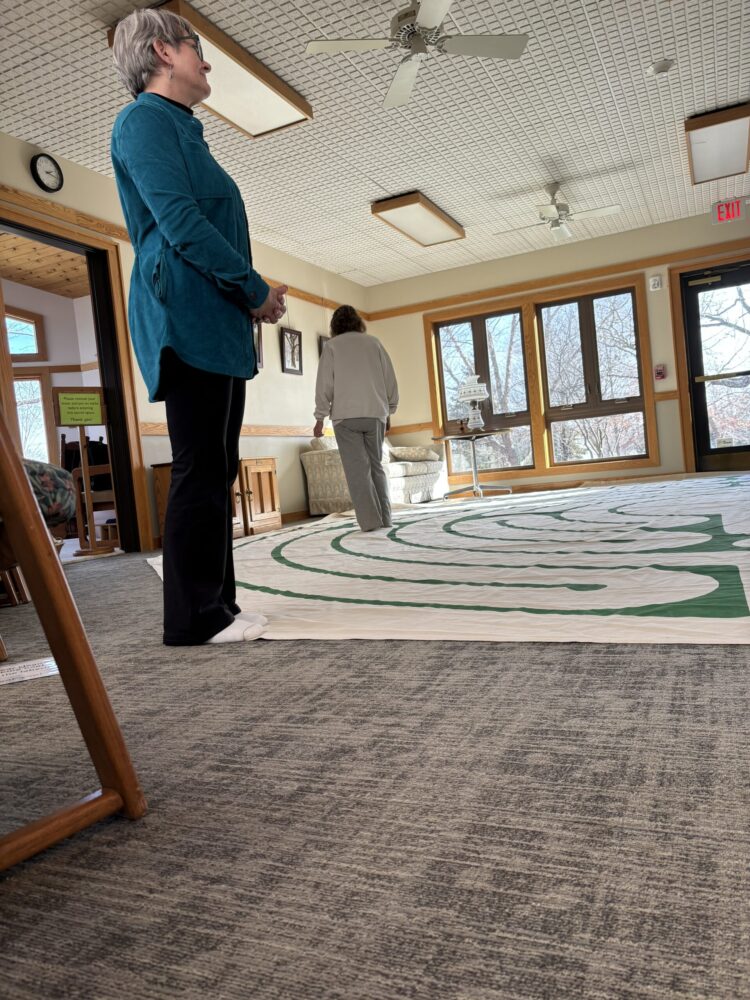
-
St. Bridgit’s Day Walk
-
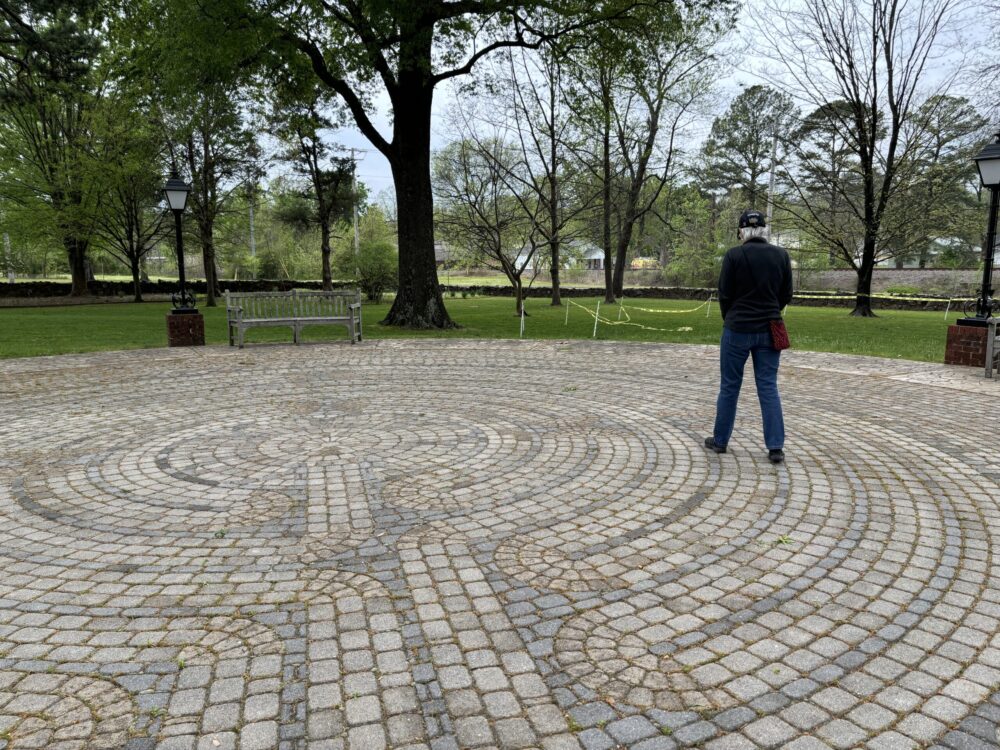
-
Twylla Alexander walks the Hendrix College labyrinth, Conway, AR
Spring to Summer
One of my joys is to periodically help host handheld labyrinth walks through Veriditas. Each Friday since March 2020, Veriditas has hosted free walks. As many as 100+ have attended worldwide from at least four different continents. Remember this involves navigating time zones and considering seasonal differences in the Southern and Northern Hemispheres!
December 2023 when I guided a “finger” walk, the North Polar Bear who comes out annually with the Father Christmas stories, jumped up and created quite a stir! Viewers grabbed their Teddy Bears and other “stuffies” and joined in the chaos. I could hardly contain anyone! Soooooo, North Polar Bear set the idea of play in the labyrinth.
This gave rise to the yoga class participants from the Nassif Community Cancer Center coming to the Phoenix Harmony Labyrinth. We’ve walked before and enjoyed a potluck. This year they gamely joined in what is known as the Appleton Dance which works well on a dual-entry five-circuit labyrinth. Laughter and clapping drifted over the yard.
Sometimes a pilgrim quietly arrives. In high summer, a Gazette reporter slowly walked the path, took photos, and sat on the bench in the shade of the birch.
Evening is always a pleasant time to walk, especially with a setting moon to frame the trees. I do miss the sounds of insects which have been diminishing over the years as loss of habitat and increase in sprays take their toll. Insects are critical for earth and human health.
-
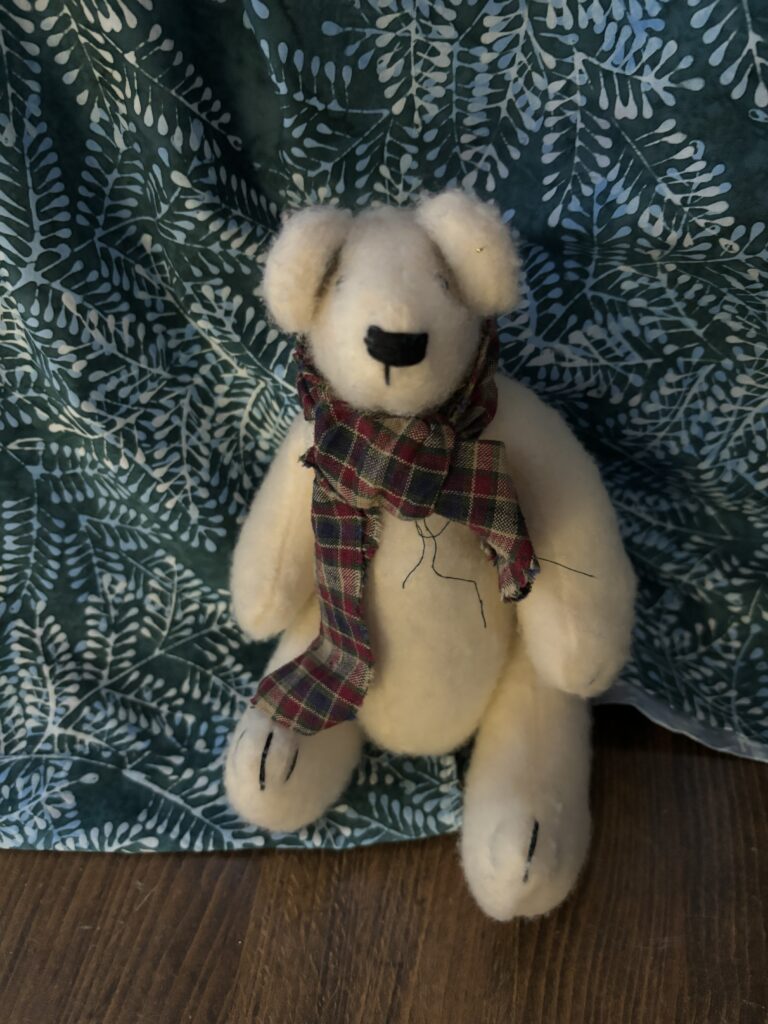
-
The North Polar Bear inspired being Playful in the labyrinth
-
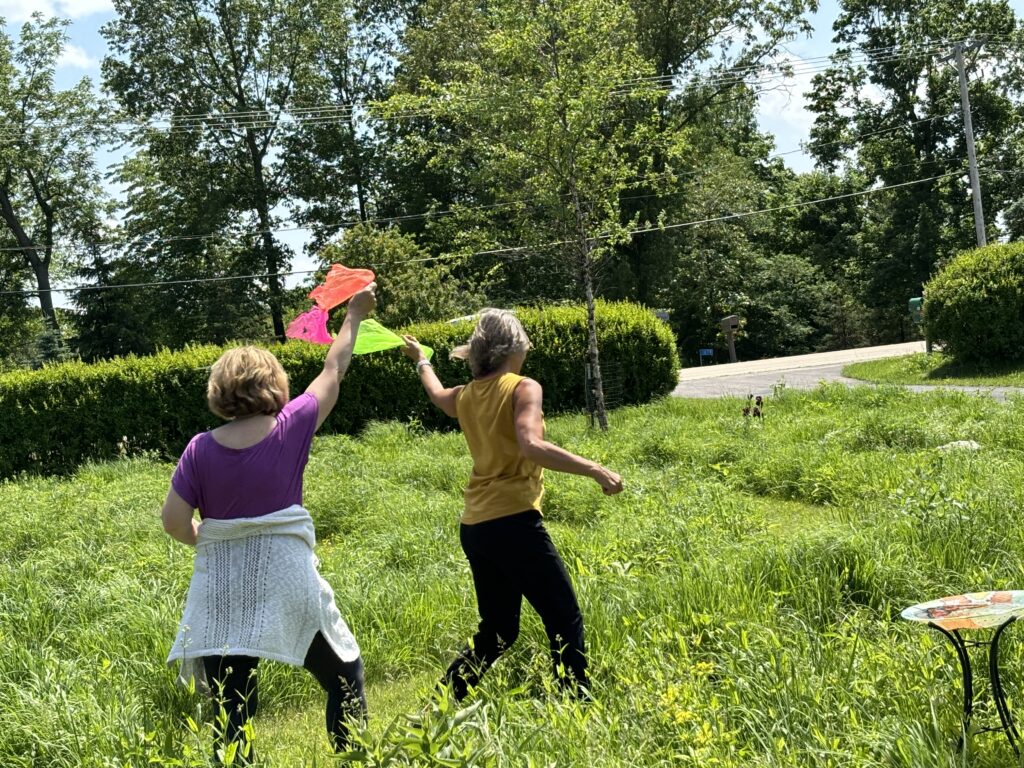
-
Adults playing in labyrinth
-
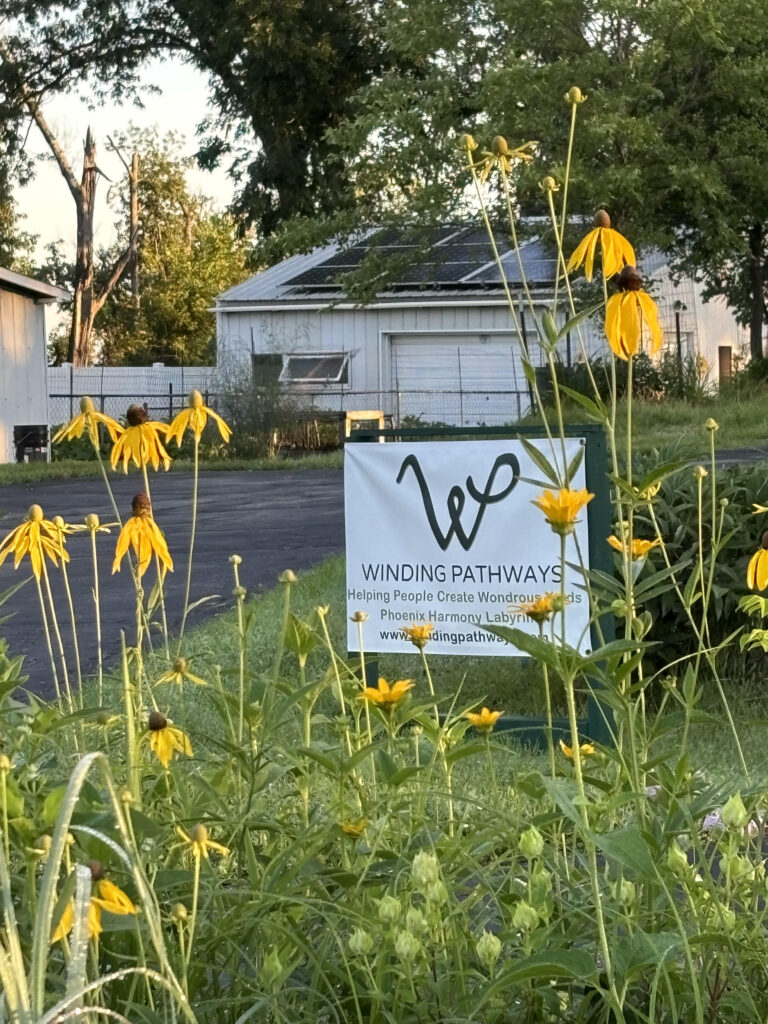
-
Winding Pathways
-
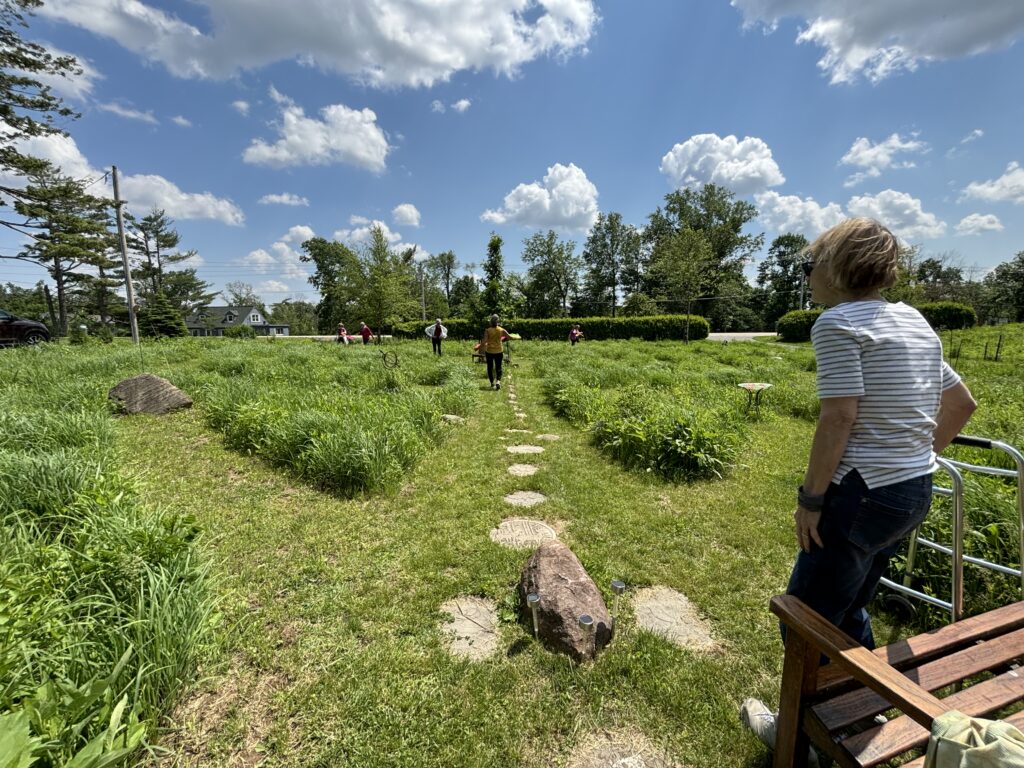
-
Holding space.
-
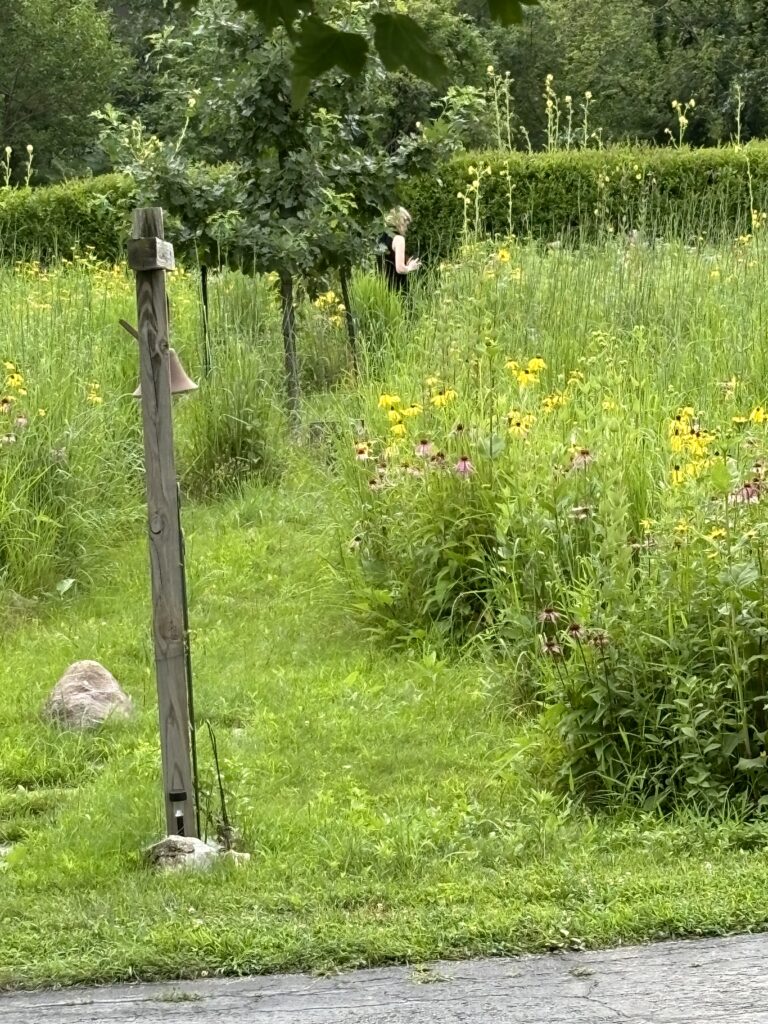
-
Summer charm
-
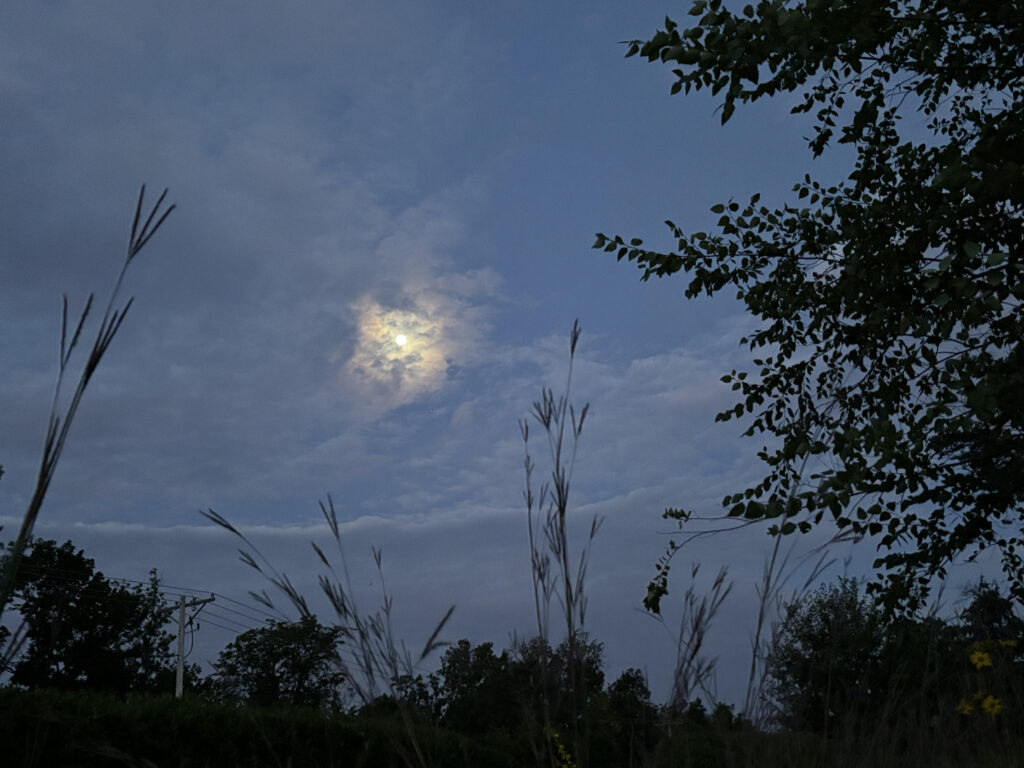
-
Evening walk
Autumn to Winter
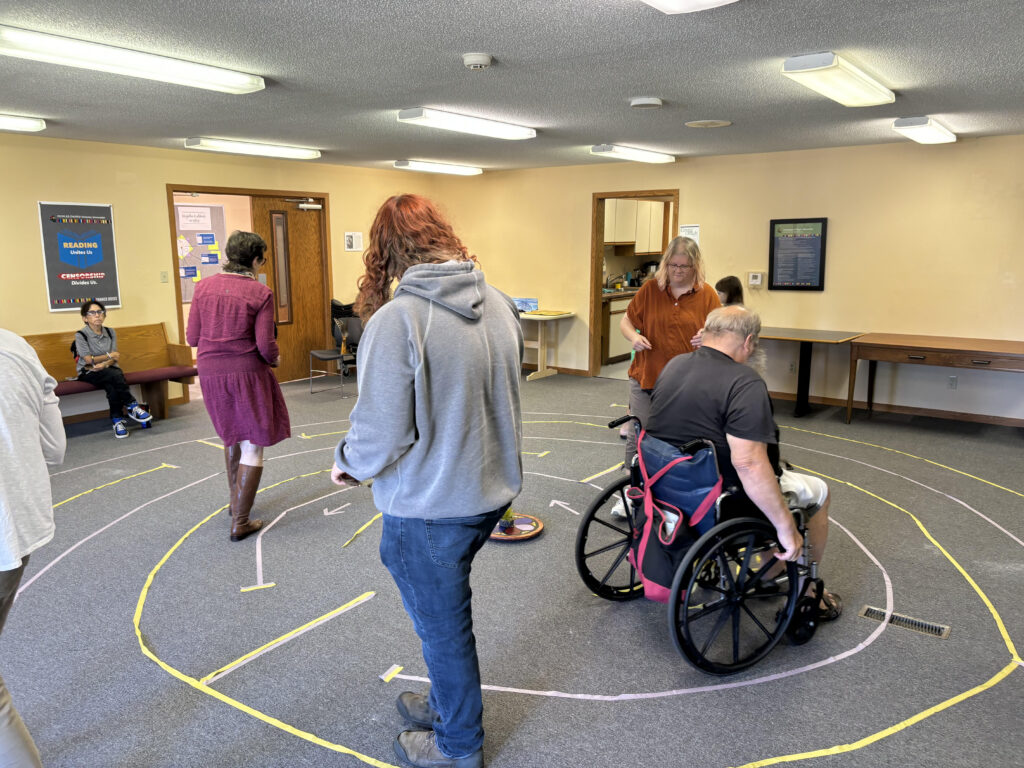
Indoor labyrinth
Our minister, the Reverend Carin Bringelson creates unique services engaging a variety of congregants. One September service featured several stops where members engaged in physical activity. This included a three-circuit processional walk that a friend, Tom, helped lay down on the Ely Room floor. We invited people to walk once to get the feel and then again more thoughtfully. People enjoyed the experience and shared their takes on the various stops after service.
Finding labyrinths 2024 was slower this year because of different types of activities.
In September, Rich and I visited Lincoln, NE. Part of our adventure before his bicycle ride was finding labyrinths. It was mostly futile. One was a pretty walking area but not a labyrinth. The other was tucked away from where anyone would choose to walk and behind an area of construction. The path leading to a pretty paved labyrinth was overgrown and uninviting. Needs love. One we simply could not find.
A similar experience in Charles City, IA, which did have a lovely paved labyrinth next to the river revealed that is was gone. To everything, there is a season.
October found me in northern California outside Yosemite at a labyrinth conference. The Gathering’s theme was “Awe and Inspiration.” Indeed the day tour into Yosemite, although brief, yielded a sense of the grandeur of this sacred place so loved by John Muir and before him, the Indigenous people who lived there.
We are not always filled with Awe and Inspiration, so what do we do when things are tough? We walk through “Ordinary” time. Not meaning dull, but time of preparation. Although connected to the liturgical sense, we all experience “Ordinary” time and Awe and Inspiration. That was the theme of my talk. How inspiring to hear people’s experiences and how they use the labyrinth to help them keep balance and return to a sense of appreciation and inspiration.
I’ve captured images of our trip below.
-
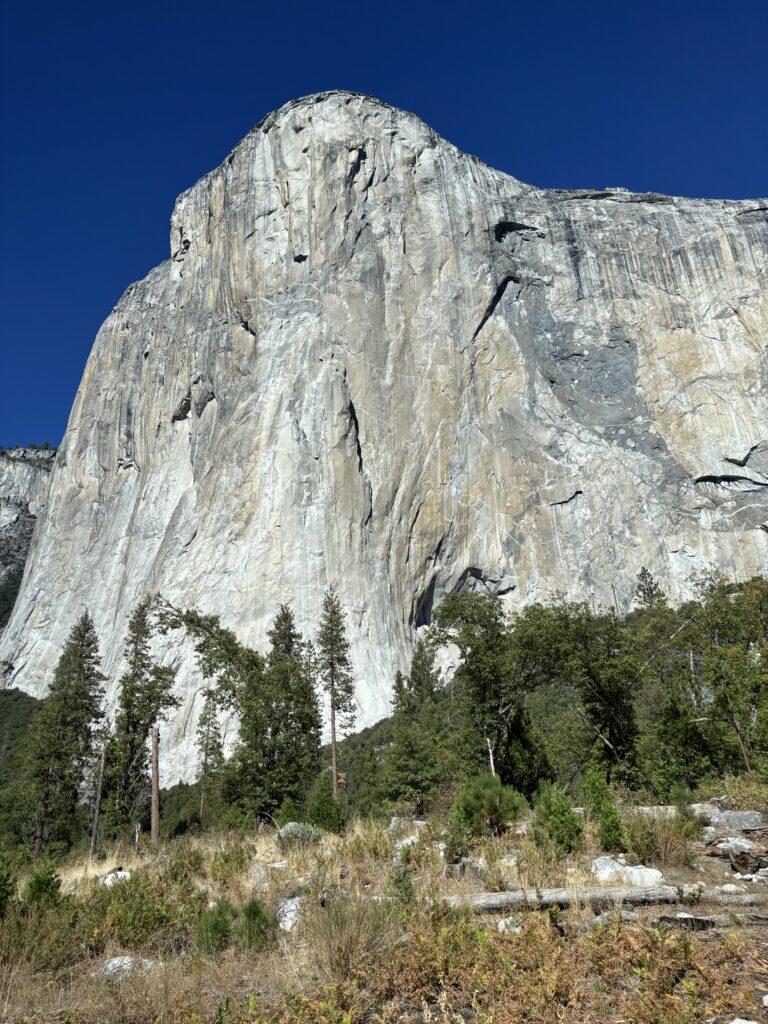
-
Sacred Space
-
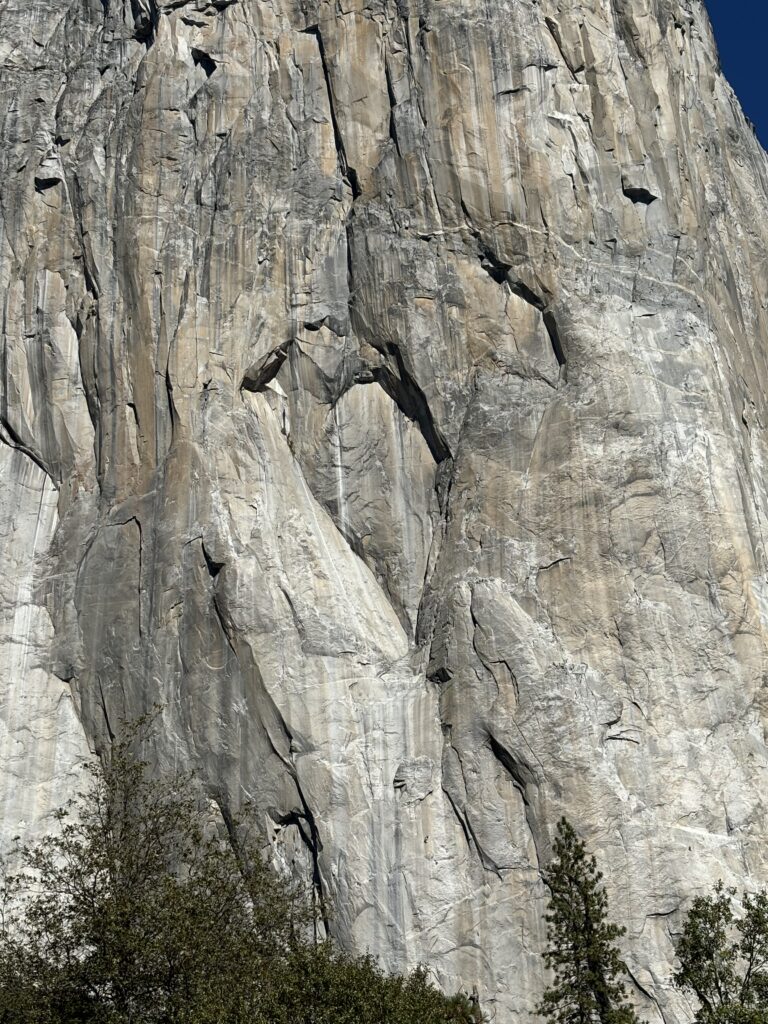
-
Enjoying the climbers on El Cap. Can you spot them? In the Heart of El Capitan
-

-
Beth Sharing music
-
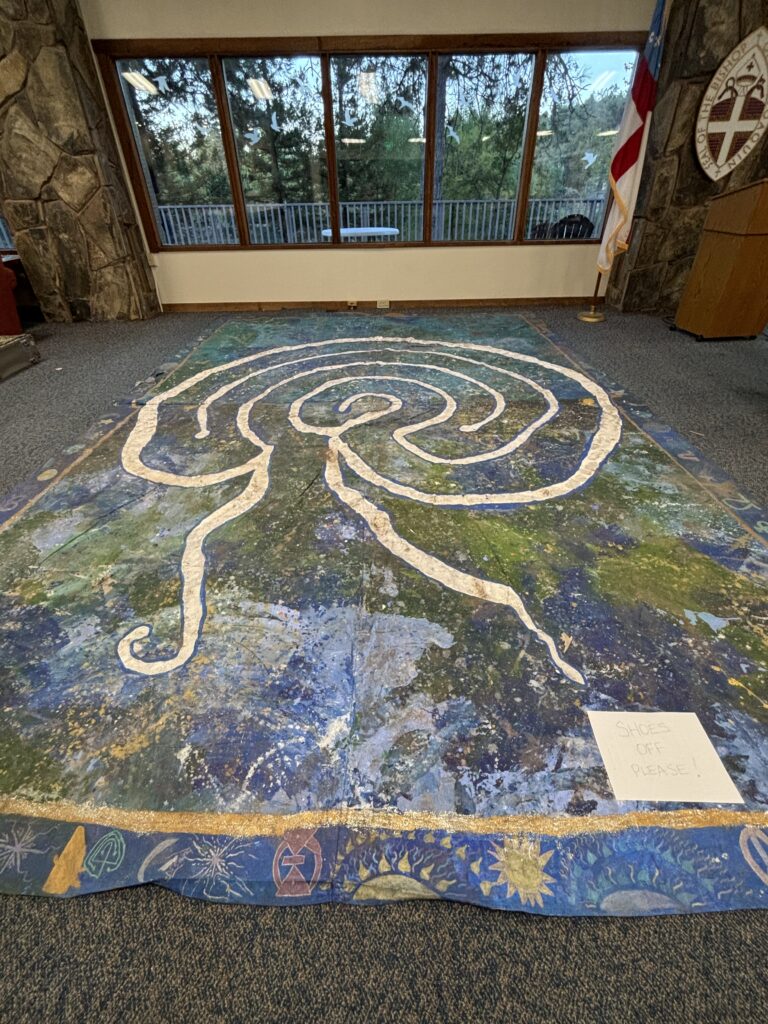
-
Unique
-
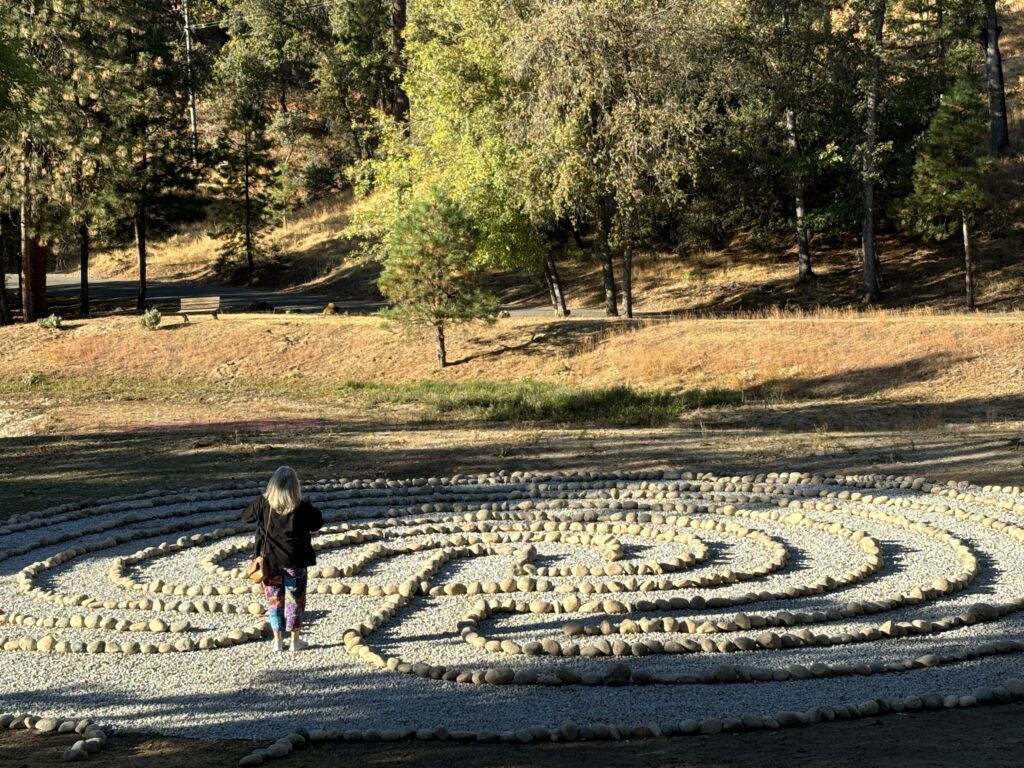
-
New labyrinth
-
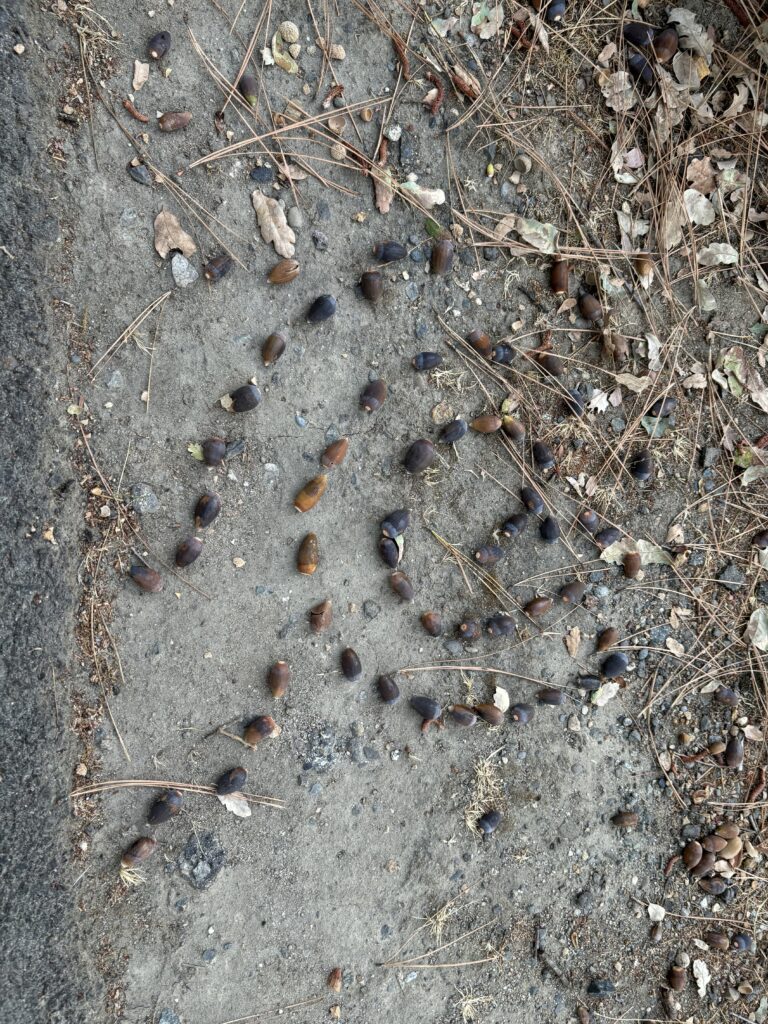
-
Labyrinths everywhere
Finally, we approach winter with our final yard task of the year. Burning the prairie and the labyrinth! My favorite activity. Now, I can walk the path, note the ashen borders, and know that come spring the Phoenix Harmony Labyrinth will emerge even more robust than ever.
-
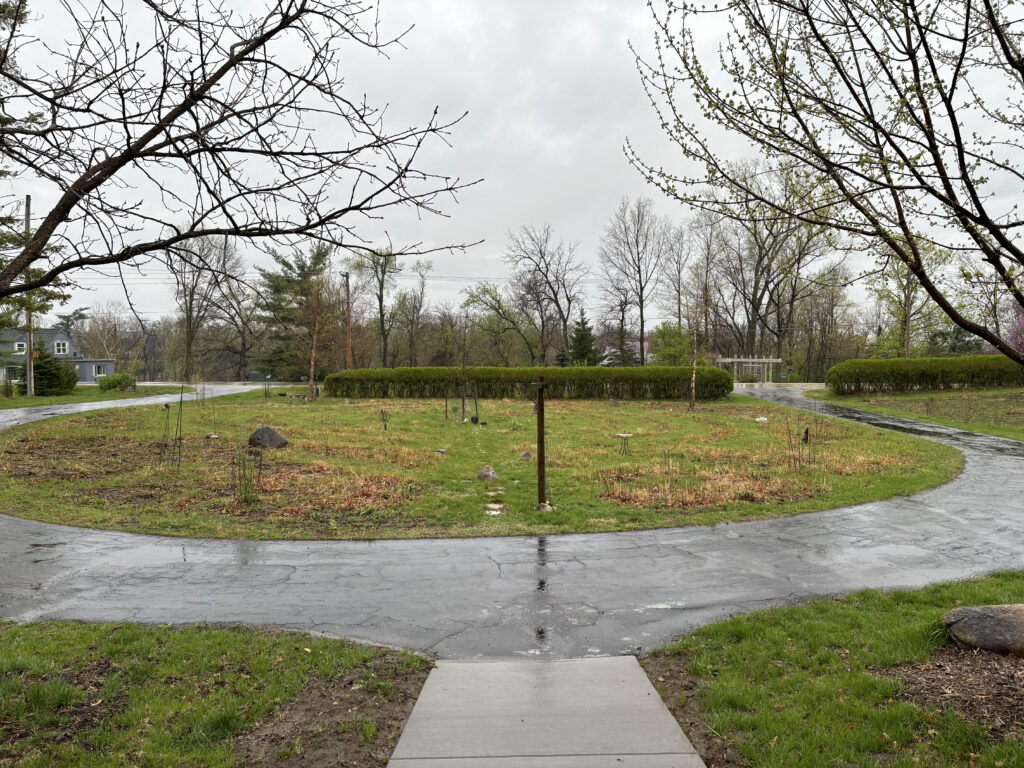
-
Early Spring from porch
-
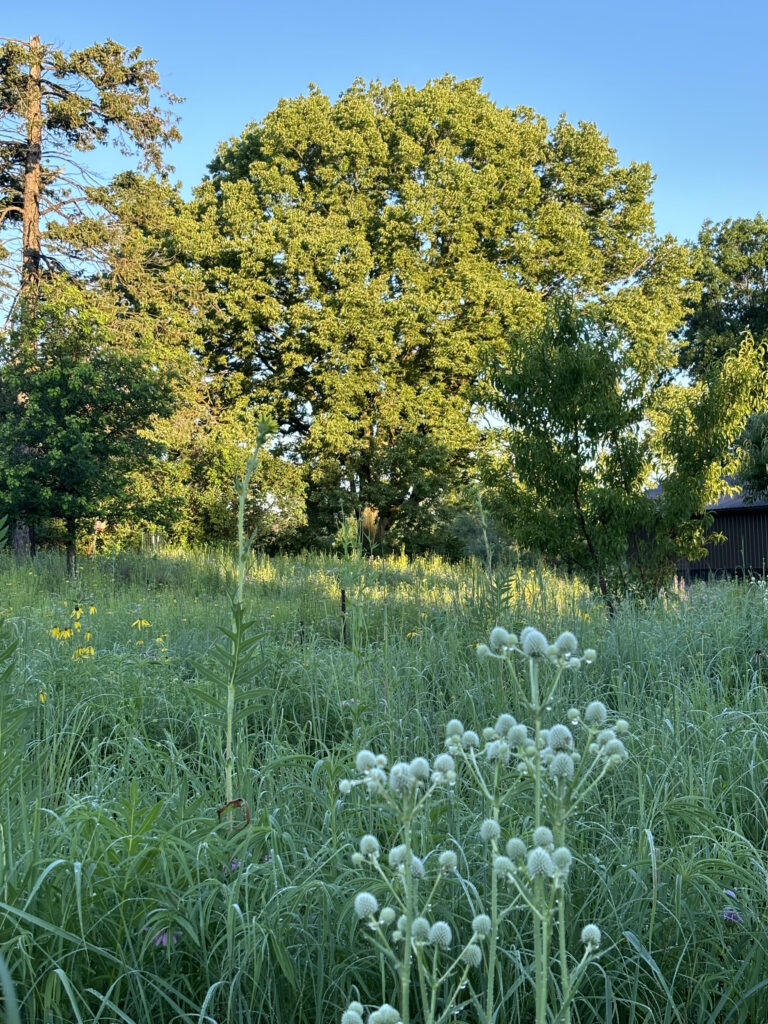
-
Summer fullness
-
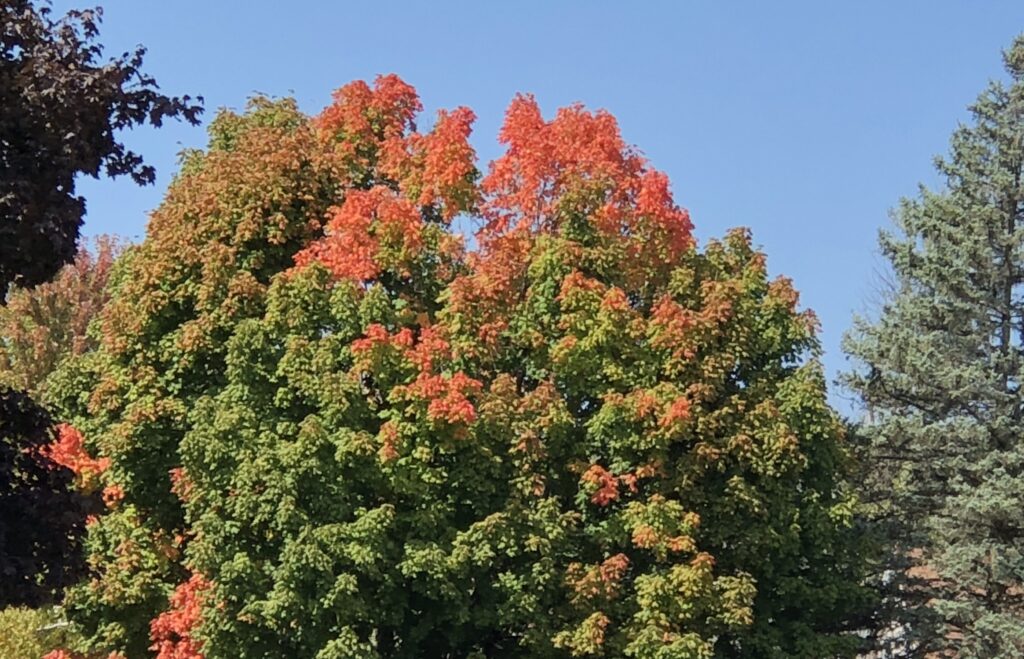
-
Fall color
Burning and winter quiet.
-
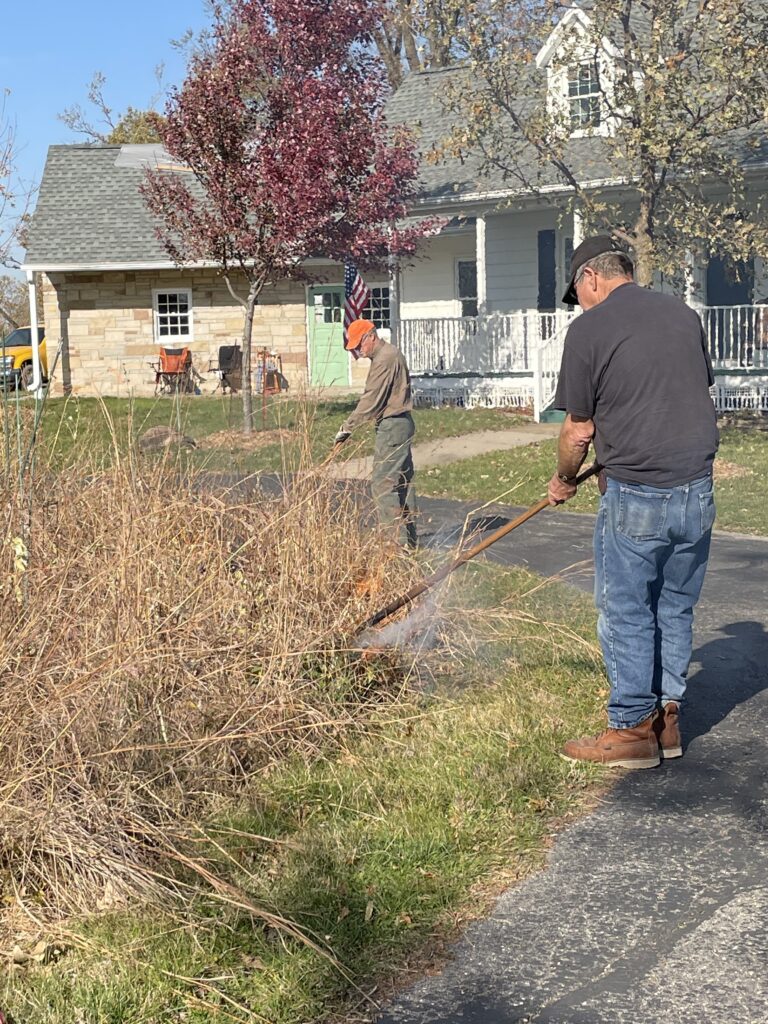
-
Moving fire into new fuel.
-
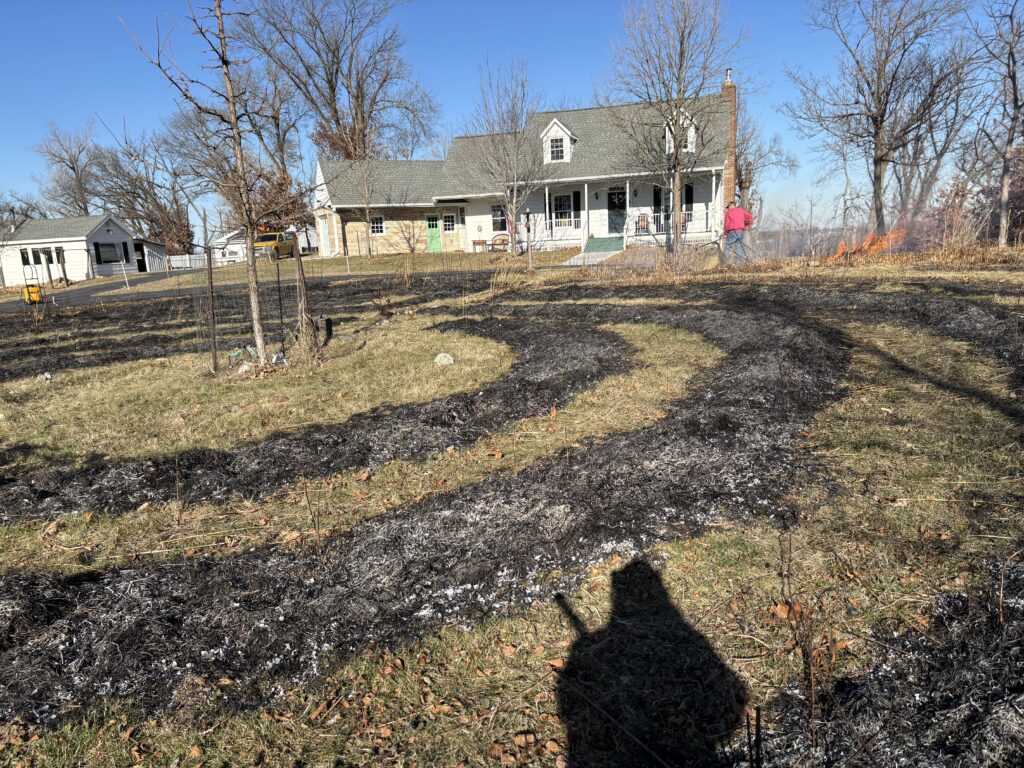
-
Rake in hand
-
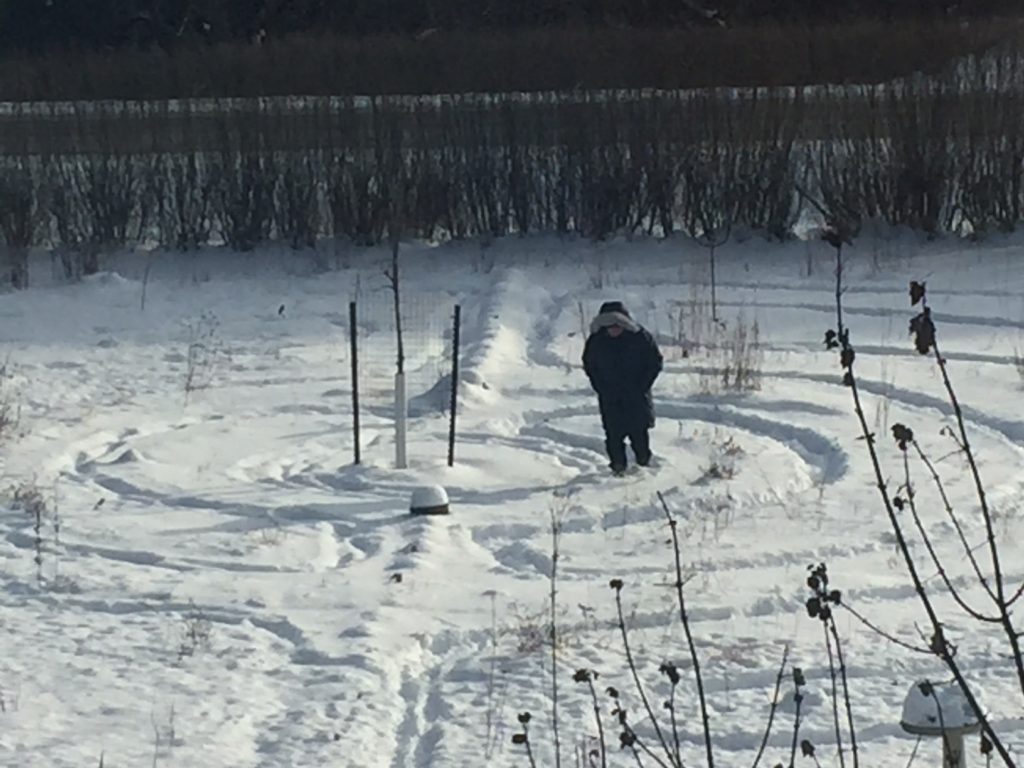
-
Walking in winter
by Winding Pathways | Jan 2, 2025 | Travel/Columns
Features: 2020 – 2024
2024
(For a list of features go to https://www.thegazette.com/marion-and-rich-patterson/)
For related articles click here.
November 10, 2024. Riding the (t)Rails. (in print copy and Green Gazette)
November 3, 2024. Land of the Dawn.
October 23, 2024. Getting the Lead Out.
August 4, 2024. Washington’s Tri-Cities Region….
July 30, 2024. How Three Iowa Lands Became Home to Restored Prairie. Feature by Bailey Chichon about our work in restoration.
June 9, 2024. Heading South to View the Eclipse….
April 7, 2024. Trave: Wild Winter Wonderland (Alaska in winter)
January 28, 2024. Wandering Pennsylvania’s Wilds
January 15, 2024. Shed Hunting Season
-
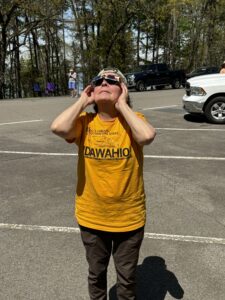
-
Safe viewing
-

-
Highlight of a unique trip.
-
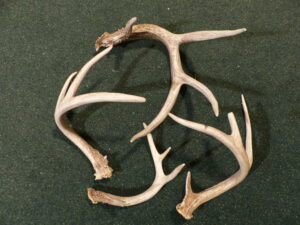
2023 – 2022
December 10, 2023. Breathtaking Views (firetowers)
September 10, 2023. Peaceful Prairie (Grasslands of Saskatchewan, CAN)
August 5, 2023. Fly Fishing. (no link to date. Available Green Gazette)
July 16, 2023. Intriguing Riddles From the Hopewell Culture.
May 29, 2023. Head for The Hills. (Black Hills off Season)
May 21, 2023. Moving Heaven and Earth. (Earth Moving Legacy Museum)
May 5, 2023. Ax Throwing: a Fun Historic Skill.
April 2, 2023. Agritourism Attraction. (Fair Oaks Farms)
March 5, 2023. Seeking Independence. (Truman Presidential Library)
February 3, 2023. A Gem in Pennsylvania’s Laurel Highlands.
January 6, 2023. Ike’s Town. Abilene, Kansas & Western History.
December 4, 2022. Trap Shooting.
September 6, 2022. Riding the Rails (Alaska by Train)
July 17, 2022. Backyard Adventures. (No link to date)
July 11, 2022. Casper, WY, Gateway to the West.
May 12, 2022. Hobo Convention.
May 8, 2022. Splish Splash! Whitewater Kayaking in Iowa. (No link to date)
April 22, 2022. Finding America On Roadways East.
April 13, 2022. Muscle Over motor When Boating.
March 21, 2022. Rockhounding.
January 30, 2022. Backpacking Bonus. (8B of GZ. No link to date) Available Green Gazette.
January 24, 2022. Distinctive Religious Structures.
January 16, 2022. Hiking Wild Areas. (no link to date) Available Green Gazette.
-
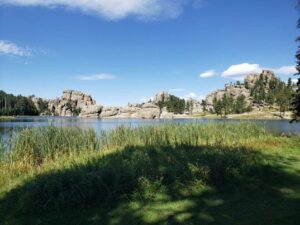
-
A favorite spot in the Black Hills
-

-
View of an iconic Cedar Rapids church.
-
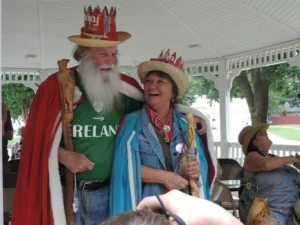
-
A grand time in Britt, Iowa
2021-2020
December, 2021. Country Schools. (no link to date) Available Green Gazette
November 15, 2021. Making a (Mini) Pitch for Soccer.
October 6, 2021. A visit with Midwest’s Pioneering Authors.
September 8, 2021. Taking a Slow Boat to Cassville.
September 6, 2021. Camping in Iowa’s Trout Country & Decorah’s Celebrities.
August 4, 2021. Parking While Headed East. And Solar Panels at Peoples.
June 13, 2021. Alaska Recreation.
May 22, 2021. Museums of Quad Cities Area. https://www.thegazette.com/recreation/the-many-museums-of-the-quad-cities/
April 18, 2021. Finding Amelia. https://www.thegazette.com/recreation/an-unexpected-search-for-amelia-earhart/
April 11, 2021. Mississippi river Museum and Dubuque
March 25 , 2021 Cedar Falls_Waterloo. Memorable Museums
March 12, 2021. Time Travel. https://www.thegazette.com/subject/sports/outdoors/time-traveling-in-iowa-20210312
March 3, 2021 Entering the Battery Age (column)
February 19, 2021. Franconia Sculpture Park. https://www.thegazette.com/subject/sports/recreation/art-walk-in-a-park-20210219
February 2, 2021. Sprint Cars. https://www.thegazette.com/subject/sports/auto-racing/a-sprint-car-education-20210202
January 14, 2021. Embrace the Outdoors. https://www.thegazette.com/subject/sports/outdoors/embracing-x2014-and-enjoying-x2014-the-cold-outdoors-20210114
-

-
Sunset over Cook Inlet.
-

-
A short ride short to shore.
-
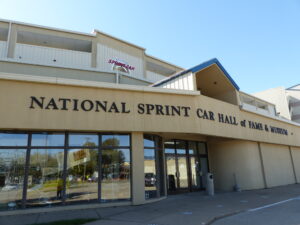
-
A popular sport in Iowa.
*****
December 20, 2020. Walking Cemeteries. https://www.thegazette.com/subject/sports/outdoors/a-peaceful-outdoor-walking-option-20201221
December 14, 2020 Iowa Meat Lockers: https://www.thegazette.com/subject/sports/outdoors/a-meaty-adventure-20201214
Nov 11, 2020 Iowa’s Inland Seas. https://www.thegazette.com/subject/sports/outdoors/enjoying-iowas-inland-seas-20201111
Oct 11, 2020. Barn Quilts. https://www.thegazette.com/article/barn-quilts-offer-brighten-up-the-countryside/
Sept 27, 2020: New Life to Dead Trees. https://www.thegazette.com/subject/sports/outdoors/dead-trees-give-life-20200927
September 20, 2020: Walk Outside Safely. https://www.thegazette.com/subject/sports/outdoors/get-outside-and-walk-but-stay-safe-20200920
September 9, 2020: Rebirth Amid the Rubble https://www.thegazette.com/subject/sports/outdoors/a-rebirth-among-the-rubble-of-trees-20200906
August 22, 2020: Iowa’s National Parks. https://www.thegazette.com/subject/sports/outdoors/iowa-national-parks-guide-effigy-hoover-20200822
July 27, 2020: County Parks. https://www.thegazette.com/subject/sports/outdoors/take-advantage-of-iowas-county-gems-20200727
July 11, 2020: Tenting. https://www.thegazette.com/subject/sports/outdoors/why-rv-live-isnt-for-these-senior-tent-campers-20200711
June 26, 2020: Bear Sightings in Iowa: https://www.thegazette.com/subject/sports/outdoors/why-rv-live-isnt-for-these-senior-tent-campers-20200711
April 12, 2020” Walk on Wilder side. https://www.thegazette.com/subject/sports/recreation/take-a-walk-on-the-wilder-side-20200412
-
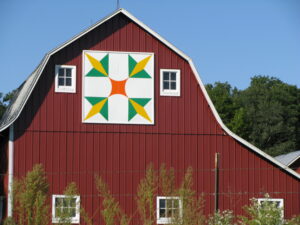
-
Iowa’s Barn Quilt Trails are fun to take.
-
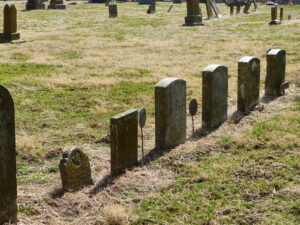
-
Some Union Some Confederates
-
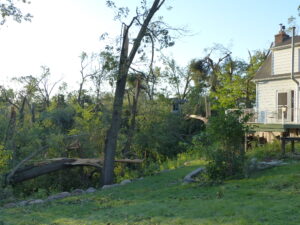
-
Felled trees.
by Winding Pathways | Dec 26, 2024 | Flowers/Grasses, Trees/Shrubs
Historic Background and Reason For Prescribed Burning
After the glaciers retreated over 9,000 years ago fires swept across much of North America, set by Native Americans and occasionally started by lightning. Fire created the vegetation and wildlife Europeans found during settlement and westward expansion.
Europeans disdained and feared fire. They suppressed it while introducing many invasive exotic plants. This has created a forest landscape of large trees with an understory of shade-loving exotic vegetation in place of former savannas.
Europeans didn’t understand nor appreciate varied ecosystems like prairies. Even as farmers and ranchers used the open lands for crops and grazing, little did they realize the importance of fires. Fires sweeping across prairies invigorate grasses and wildflowers while killing any brushy plants that try to move in.
What Fire Favors:
- It tends to favor grasslands over forests.
- It tends to create and maintain savannas.
- It tends to favor native over exotic vegetation.
- It tends to favor some native tree species over others. In general, trees that produce large nuts, such as oaks, hickories, and walnuts tend to be fire-resistant or dependent. Trees that create small seeds, such as elms, ashes, and maples tend to be fire-tender. The impact of repeated fires shifts dense woodlands to savannas dominated by oak and hickory and, in drier areas, prairies.
-
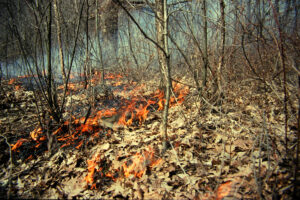
-
A cool forest burn
-
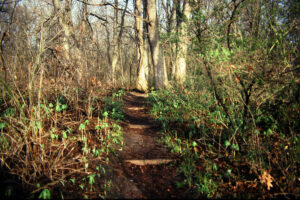
-
Burns open up sunlight for spring ephemerals.
Impact of Prescribed Burns on Prairies
Prescribed burning tends to:
- Remove insulating dead grasses, allowing the sun to warm the soil. This, favors warm season prairie plants.
- Create ash, which enriches the soil by recycling nutrients.
- Stimulate native species.
Note: burning in fall tends to favor forbs (wildflowers) while early spring burning favors prairie grasses.
Safety for Persons Conducting Burns
- Have a fire permit and adhere to its requirements.
- Wear natural fiber clothing, leather gloves, and sturdy boots.
- Understand fire behavior. See below.
- Stay out of unburned fuel and know where safe locations are. Safe locations include already burned areas, paved or gravel surfaces, and mowed lawns.
- Understand a clear burn plan as presented by the coordinator and follow directions.
- Be aware of where all people are during the burn.
- Have a cell phone with the number of the fire department programmed in.
- Have appropriate fire management tools handy and a first aid kit.
- Know about how to survive should one be “caught” by a fire.
- Be aware of “defense in depth”. (Have a second location to hold a fire should it get out of control.)
-
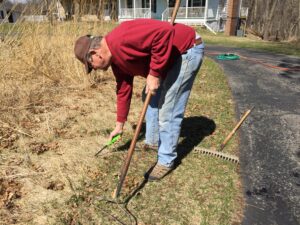
-
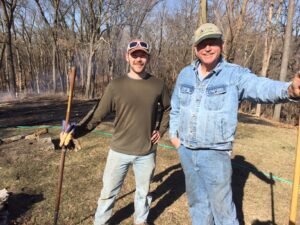
-
Mentoring younger fire managers.
Fire Behavior
Fires behave based on three factors: Fuel, Topography, and Weather.
Fires tend to burn faster:
- Upslope rather than on the flat or downhill.
- With the wind.
- With low humidity.
- With dry fine fuel.
Knowing these tenets of fire behavior helps plan burn strategy. For example, if the humidity is low, wind is moderate, and fuel is dry and fine it may be prudent to burn slowly into the wind or downslope. However, if the humidity is high and the wind is low it is likely prudent to burn with the wind, after creating a safe firebreak. These assume flat terrain.
-
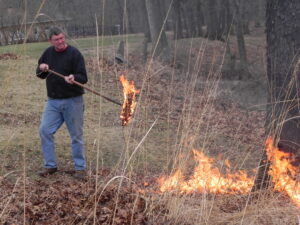
-
Rich moves fire to new fuel.
-
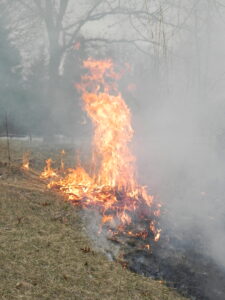
-
Burn Against Wind
A skilled person planning a prescribed burn considers all these factors before striking a match and conducts the fire most prudently.
Conducting a prescribed burn is one of the most effective ways to restore a semblance of America’s traditional vegetation.
-
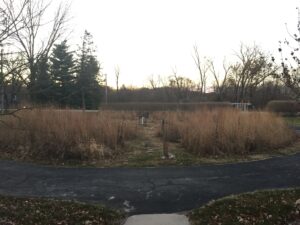
-
Pathways and prairie grasses.
-
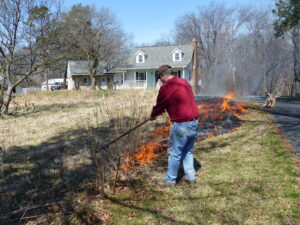
-
Stand out of fuel.
-
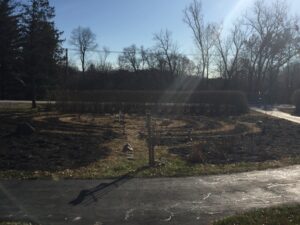
-
Dark soil warms the earth.
by Winding Pathways | Dec 19, 2024 | Geology/Weather, Nature

Frosted glass!
The world around Winding Pathways changed overnight. On December 14, 2024, we awoke to an ice-glazed world. We know that hurricanes, tornadoes, and derechos cause widespread havoc. Ice storms present their own perils to trees, people, and wild and domestic animals.
After lighting our woodstove, we pulled traction devices on our boots, grabbed trekking poles, and ventured outside just long enough to check for damage, gather eggs, and fill bird feeders.
Checking for Damage
Ice crystals sparkled and ice sheets reflected morning’s light in unusual ways as we carefully picked our way around the yard. Fortunately, we found no downed tree limbs and our chickens were tucked safely inside their coop. Wild birds had no choice. We filled all our feeders, sprinkled seeds on the ground, and scattered sand. Some we tossed on walkways to provide traction for us and a few scoops went amid the birdseed under our feeder. Birds need grit for digestion and it’s hard to find when the world is icy.
Helping the Birds
Many winter birds feed on frozen insects and spiders tucked into the crevices of tree bark. Others scratch through leaves to find seeds and bugs. With trees and the ground sheeted in ice, pickings were slim for animals that must eat an enormous amount of food daily to maintain a body heat of around 106 degrees.
It’s no wonder that cardinals, juncos, nuthatches, blue jays, chickadees, and the five species of woodpeckers in Iowa crowded our feeder and the ground underneath it on that icy morning. Starlings and house (English) sparrows soon showed up.
The overnight ice storm was not so thick that the tiny birds got trapped under the flap of bark where they often rest in storms. They were able to break out and get to the feeder before other birds arrived.
-
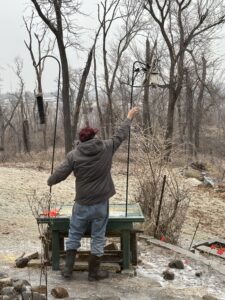
-
Ice was so thick Rich hit with a pole to loosen it.
-
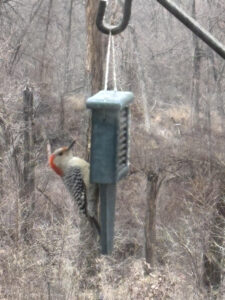
-
Birds came early.
Turkeys Arrive
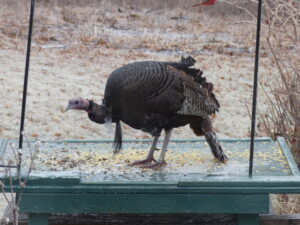
Wind ruffling back feathers.
We wondered when the gang of turkeys would show up and whether they weathered the night in the tops of the swaying and ice-encrusted trees. Late morning “Louie the Lonely Turkey” carefully picked his way across the frozen grass. What a surprise when he hopped up on the top of the sheet of ice on the platform feeder! He shot off the other end and, doing a pirouette like Sam Gribley in My Side of the Mountain, thumped down quite flummoxed when he stepped onto the ice after an ice storm. Louie gingerly climbed back up onto the platform feeder. And, we had our answer as to where he had slept. One side of his feathers and beard were crusted with ice. He had endured a cold night swaying in the tops of the tree as usual. The others haven’t shown up yet, so Louie feasted on the corn and sunflower seeds.
Deer Stayed Put
One backyard animal was initially absent. Often deer visit at night or early each morning but the icy glaze covers their food and makes walking treacherous. Unlike birds, deer put in a thick layer of fat each fall. During storms, they find a sheltered spot and “hole up”. They can sit still for several days without feeding to ride out a storm. A few did finally show up, realized the table goodies were again covered with ice from the day’s rain turned to ice, and left discouraged.
Squirrels Tried to Forage
Squirrels didn’t fare too well foraging and seemed to hole up in their tree holes or nests made of clumps of leaves in the tree tops. The previous night must have been quite the ride for them as well as the turkeys with the trees swaying and ice cracking on limbs.
Prairie Grasses Haven for Small Animals In Ice Storms
The prairie grasses on the knoll bent over with ice formed small enclosures where our resident cottontail took refuge. Deer tracks crossed the Harmony Phoenix Labyrinth as they wandered in the night.
-
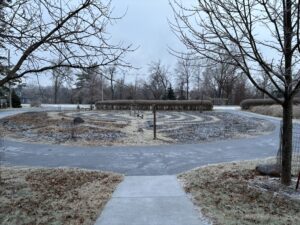
-
Contrast in color and texture.
-
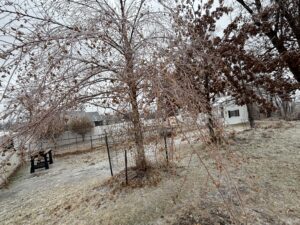
-
Birches bending under the weight. of the ice storms
Robert Frost had it right in his poem, Birches, “When I see birches bend to left and right, Across the lines of straighter darker trees, I like to think some boy’s been swinging them. But swinging doesn’t bend them down to stay. As ice storms do.”
The ice will melt as temperatures rise. Until it does, we’ll walk cautiously to reduce the odds of falling and keep our feeders well-stocked with seeds and grit.




















































